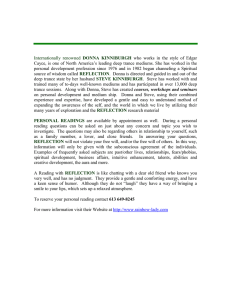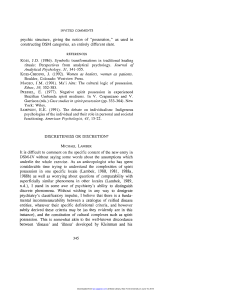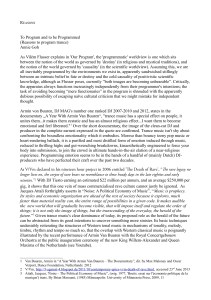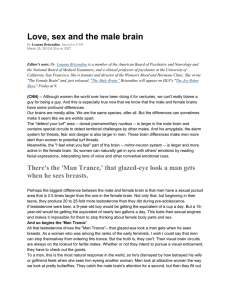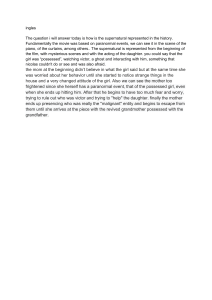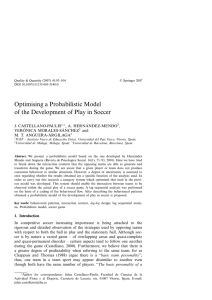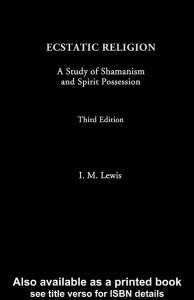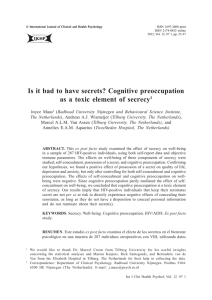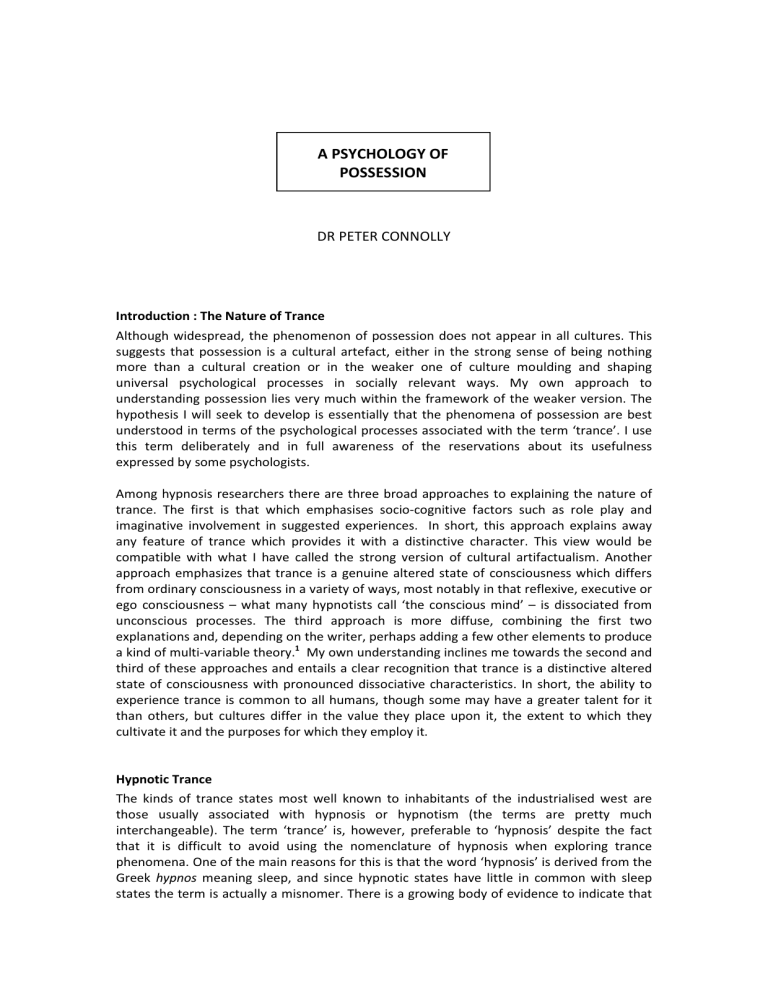
A PSYCHOLOGY OF POSSESSION DR PETER CONNOLLY Introduction : The Nature of Trance Although widespread, the phenomenon of possession does not appear in all cultures. This suggests that possession is a cultural artefact, either in the strong sense of being nothing more than a cultural creation or in the weaker one of culture moulding and shaping universal psychological processes in socially relevant ways. My own approach to understanding possession lies very much within the framework of the weaker version. The hypothesis I will seek to develop is essentially that the phenomena of possession are best understood in terms of the psychological processes associated with the term ‘trance’. I use this term deliberately and in full awareness of the reservations about its usefulness expressed by some psychologists. Among hypnosis researchers there are three broad approaches to explaining the nature of trance. The first is that which emphasises socio-cognitive factors such as role play and imaginative involvement in suggested experiences. In short, this approach explains away any feature of trance which provides it with a distinctive character. This view would be compatible with what I have called the strong version of cultural artifactualism. Another approach emphasizes that trance is a genuine altered state of consciousness which differs from ordinary consciousness in a variety of ways, most notably in that reflexive, executive or ego consciousness – what many hypnotists call ‘the conscious mind’ – is dissociated from unconscious processes. The third approach is more diffuse, combining the first two explanations and, depending on the writer, perhaps adding a few other elements to produce a kind of multi-variable theory.1 My own understanding inclines me towards the second and third of these approaches and entails a clear recognition that trance is a distinctive altered state of consciousness with pronounced dissociative characteristics. In short, the ability to experience trance is common to all humans, though some may have a greater talent for it than others, but cultures differ in the value they place upon it, the extent to which they cultivate it and the purposes for which they employ it. Hypnotic Trance The kinds of trance states most well known to inhabitants of the industrialised west are those usually associated with hypnosis or hypnotism (the terms are pretty much interchangeable). The term ‘trance’ is, however, preferable to ‘hypnosis’ despite the fact that it is difficult to avoid using the nomenclature of hypnosis when exploring trance phenomena. One of the main reasons for this is that the word ‘hypnosis’ is derived from the Greek hypnos meaning sleep, and since hypnotic states have little in common with sleep states the term is actually a misnomer. There is a growing body of evidence to indicate that the relaxation and sleep-like characteristics often associated with hypnotized persons are actually artefacts of the induction procedure rather than intrinsic features of the hypnotic or trance state itself. The subjects of a stage hypnotist who perform a wide range of, often amusing, antics are in trance throughout the performance as are those people who engage in an action on the basis of post-hypnotic suggestion. In this latter case the cue they have been prompted to act upon re-induces the trance state.2 As Robert Temple points out, it is active states of trance that are most commonly referred to in anthropological literature, some writers actually restricting the use of the term ‘trance’ to such active conditions. Hypnosis researchers have tended to go in the opposite direction and ‘... persist in believing that all trances must involve subjects drifting off to sleep-like states with suggestions of drowsiness’.3 Things have begun to change, however. Perhaps starting with W. R. Wells in the 1920s, a few researchers have been exploring the relationship between hypnotic trance, where participants are encouraged to relax, and what Arnold Ludwig and William Lyle call alert or hyper-alert trance.4 These two types of trance have been found to be similar in terms of eliciting the characteristic hypnotic phenomena such as analgesia, perceptual distortions and involuntary movements, as well as in terms of subjects passing easily from one kind of trance to the other. As Bányai and Hilgard comment, in alert trance ‘... all the important characteristics of hypnosis occur except the resemblance to sleep’.5 Induction Techniques Some notable differences have also been observed. In hypnotic trance subjects are physically relaxed whereas in alert trance they frequently display tension or rigidity. In hypnotic trance the experience of a blank mind is common during periods when the hypnotist is not making suggestions, whereas those who have experienced alert trance frequently report a cascade of thoughts and emotions. In hypnotic trance subjects often describe a deep sense of calm and mental tranquillity whereas in alert trance they tend to talk more about having ecstatic or peak experiences.6 Another reason for preferring the term ‘trance’ to ‘hypnosis’ is that the latter is frequently understood to be something that one person does to another. Certainly trance states can be induced by one person talking to, touching or making passes over another. But they can be induced in other ways as well, not all of which involve another person. Individuals can put themselves into trances (auto-hypnosis) as well as have other people do it for them (heterohypnosis). Many rituals link the two by providing a socially constructed context for the facilitation of auto-hypnotic strategies. Stephen Gilligan offers the following as a list of trance induction techniques: ... rhythmic and repetitive movement (dancing, running, rocking, breathing exercises, etc.); chanting (meditation, prayer, group rituals, chants at rallies or sports events, the repetitive self-talk of depression, etc.); attentional absorption (on a mantra, the hypnotist’s voice, an image, an idea, the television, etc.); and balancing of muscle tonus (via relaxation processes, 7 massage, drugs such as alcohol or valium, rhythmic movement, etc.) We could add to this list factors such as exposure to stress,8 extended periods of solitude and loss of bodily equilibrium combined with a loud noise.9 Whatever their means of induction one thing that all trances have in common, according to Gilligan, is that they ‘... tend to decrease the discontinuous, arrhythmic movements of 2 deliberate conscious orientation, thus giving rise to a more unified mode of experience’.10 At the heart of trance experience then is what we might call the displacement of the conscious mind, other terms for which are reflexive consciousness and ego. The conscious mind performs a number of important mental functions. It ‘can be thought of as a blackboard available to all the various subsystems of the brain’.11 It is thus a link between these subsystems and, as such, has an integrating function – particularly through memory which, as Peter Brown puts it, is ‘... the matrix of personal identity’.12 It works, according to Gilligan, by ‘... structuring information into action frames or programs (mental sets) and sequencing and computing conceptual relationships’.13 It is also highly sensitive to context – that is, it is realistic. It is the locus of what Ronald Shor calls the generalized reality orientation.14 This makes it conservative rather than creative; more of a manager than an artist. The Conscious Mind The conscious mind is thus permissive rather than initiatory. It can allow ideas emerging from the unconscious to be implemented in behaviour or it can veto them. This power of veto enables the conscious mind to ensure that implemented ideas conform to the frame or map of the world with which it is operating. The way the veto functions is, in part, by the narrowing of attention to what Gilligan calls ‘frame-relevant stimuli’. Such attentional control both arises from and is maintained by muscular tension patterns.15 The conscious mind is not, however, a unitary process. Ernest Hilgard, for example, distinguishes between what he calls the executive and the monitoring functions. He writes, Central executive functions are responsible for planning in relation to goals, initiating action 16 commensurate with these plans, and sustaining action against obstacles and distractions. The monitor, by contrast, ... has a scanning function that includes alertness to all that is taking place, a recognition of the familiar, and a readiness for the unexpected... In addition to scanning and selection the monitoring function includes a critical or judgmental role, based on feedback from initiated 17 action as what is done is compared with intended goals and performances. The only really contentious point in this description of conscious processes is the claim that executive processes initiate action. Drawing on research carried out by Benjamin Libet during 1985, the year that Hilgard revised Divided Consciousness, Robert Ornstein argues that even when action appears to be initiated by conscious processes it is unconscious ones that are often the real driving force. Libet’s work was concerned with what he called ‘readiness potential’ brainwaves. These occur only before movements we experience as being consciously willed whether they be calculated or spontaneous. They begin around a second before we become conscious of making a decision to act. It seems then, that even many of the activities which seem to be initiated by our conscious selves would appear to be generated unconsciously – albeit in response to a consciously thought out plan.18 When the conscious mind is displaced or dissociated unconscious processes are given a free rein as it were, guided only by the directions of the hypnotist, the social context or some goal determined prior to or during the induction procedure. Trance experience is thus significantly different from ordinary experience. Gilligan enumerates and describes its principal features. These include attentional absorption, involuntariness, immersion in experiential and symbolic rather than conceptual processing, enhanced suggestibility, perceptual flexibility, trance logic and a tendency to be amnesic for trance experiences on return to ordinary consciousness.19 3 One thing that emerges from a consideration of this list is that the experience of trance is rarely an end in itself. Usually it is a means to the attainment of some other end. It is something like the neutral gear in a car. Changing from one gear to another usually involves engaging or passing through neutral first. Another analogy might be the wood between the worlds in C. S. Lewis’s story The Magician’s Nephew. The wood was a place of transit. From there one could go to many other worlds. Such an understanding of trance is completely in accord with the term’s Latin origins in the words transitus – a passage, and transire – to pass over. Trance states can thus provide the psychological conditions for the elicitation and exploration of a wide range of experiences. In hypnotherapy a common distinction is that which is made between trance induction and trance utilization. A trance state is relatively easy to elicit in a substantial proportion of the population by using standard induction techniques. What distinguishes the skilful hypnotherapist from the novice or the dabbler is the way in which the person is guided once in the trance state. Cultures employ trance for different purposes. In some it is employed to alleviate psychological and emotional distress, in others it is used to create memories and change identity and in yet others it is a means of facilitating possession by a deity, spirit or animal. Trance and Possession In the course of his extensive work on possession T. K. Oesterreich identifies two primary dimensions of possession and five possessing agencies.20 These are: somnambulistic-lucid; spontaneous (involuntary) – voluntary (cultivated); and possession by a demonic power, a benign power, the spirit of a deceased person, another living person and an animal. Somnambulistic possession refers to a state in which the personality of the possessor completely displaces the personality of the possessed and when, on return to the normality, the possessed is amnesic for the period of possession. By contrast, in lucid possession, the possessed ‘... does not lose consciousness of his usual personality but retains it ... he remains fully 21 conscious of what is happening; he is the passive spectator of what takes place within him’ The other dimension or axis (involuntary or spontaneous – voluntary or induced) is a little more complex. The individual who is being possessed may interpret the experience as spontaneous or involuntary though it may well have been induced by a third party, an exorcist for example. Involuntary possession is often associated with sickness and is generally treated as unwelcome, at least by the possessed person. But this is not always the case. Many Christians would welcome and count as a blessing possession by the holy spirit. Then there is the desire for what is sometimes called secondary gain. A number of writers have noted that individuals possessed by demons are often relatively powerless members of their societies, often female, for whom the take-over by a spirit provides an opportunity to express and act out socially unacceptable opinions and behaviours and effect an improvement in their social status at the same time. This latter outcome is largely a consequence of the fact that the successful identification and treatment of demonic possession serves to buttress the belief-system and maintain or enhance the influence of the exorcising authority. The possessed can thus be viewed as one of the many vehicles employed for the propagation of a particular ideology. Involuntary possession, even by a demon, may, then, be regarded as beneficial both by the possessed themselves and by the authorities which take on the responsibility for treating such conditions.22 4 Unless one is prepared to accept that the world we inhabit is populated by numerous spirits, many of which have the ability to displace an individual’s personality (and, by implication, that what we call personality is capable of existing without a body) the prima facie explanation of what occurs during possession, namely that some entity has taken over a person’s body, is unconvincing. In terms of scientific method it is also unparsimonious. The most promising alternative explanation, I would suggest, is that which is framed in terms of trance states. As was noted previously, however, trance is merely a term for a state in which a range of normally inaccessible possibilities becomes available to the entranced person. Thus, although connected by the morphology of trance, the trance-based explanations of voluntary and involuntary possession will differ somewhat as the utilization of the state is different in each case. Involuntary Possession and Exorcism Involuntary possession, I shall argue, is fundamentally the same phenomenon as Multiple Personality Disorder (MPD) or Dissociative Identity Disorder and hence the latter can be used to shed light on the former. Voluntary possession, on the other hand, seems to be much closer to what is known in the literature as deep trance identification, that is, whilst in trance modelling and taking on the behavioural and personality characteristics of another person (or being) who (or which) displays the desired skills or characteristics.23 We may note, however, that some hypnosis researchers also regard MPD as a kind of deep trance identification albeit one that has not been cultivated voluntarily.24 The phenomenology of involuntary possession and MPD is very similar. One involves possession by one or more external entities; the other involves possession by one or more internally created (though possibly externally prompted) personalities.25 The methods for identifying them are also very similar. Spanos and Gottlieb describe the beginning of the Roman Catholic exorcism procedure as follows: ... the priest was required to obtain information from the demoniac concerning the number and names of the possessing demons, their reasons for possessing the individual, the exact hour they entered the body and the length of time they intended to stay... In obtaining this and other information the exorcist addressed only the possessing demons (as opposed to the 26 person possessed) and expected to be answered only by the demons. This is an effective way of depotentiating consciousness and communicating directly with unconscious processes. In other words, it is an hypnotic technique. The parallels between exorcism and hypnosis are developed further by Spanos and Gottlieb by their reference to exorcists eliciting some of the classic hypnotic phenomena: For example, in order to impress the spectators with God’s power to perform miracles, one exorcist commanded a possessed nun to change her body into iron, and immediately her ‘body shot out straight, and the arms thrust out; and so lay the whole body of one piece as the priest .27 said’. A similar point is made by contemporary hypnotist Richard Bandler: I know a man who is famous for working with multiple personalities. He always has about twenty clients who are MPs. He’s also a good Catholic, so of course a lot of his clients are possessed. He does exorcisms out on the helicopter pad behind a hospital ... I went to see him because I was curious about his multiple personality clients. I met one of his clients in an altered state and met four or five of her personalities and the demon that possessed her. As far as I can tell, I can induce that in anybody. In fact, the way he went about introducing me to these personalities is exactly the way I would go about inducing them as a hypnotist. 5 The woman was sitting there in a chair, talking to us about how she has a lot of amnesia in her life. Nobody else does, right? Yet this psychiatrist’s convincer for knowing that you are a multiple personality is if there is any period of your life that you can’t remember! He makes up a name for whatever period you have amnesia for. According to this psychiatrist, the period that you can’t remember wasn’t you; that was another personality. He would give it some name like ‘Fred’. Then he ignores your ongoing behaviour, hits you on the head unexpectedly and calls this name ‘Fred! Fred! Come out! Come out!’. If you say ‘What do you mean, “Fred, come out?”,’ he ignores you until suddenly some other personality emerges. That’s a great way to make multiple personalities. I’m convinced that MPs are manufactured by parents and well28 meaning therapists; they are not spontaneously derived. These comments suggest that the process of identifying possessing demons and alternate personalities plays a major part in their creation as well. Indeed, throughout the late 1980s and the 1990s there has been, in America particularly, an enormous growth in reported cases of MPD and demonic possession, most if not all of which seem to have their roots in the strategies employed by certain therapists and counsellors. Such therapists tend to fall into three, sometimes overlapping, categories. The first is that of psychodynamic psychotherapists, those who work on the assumption that the best way to heal people of psychological and emotional pain is by getting them to relive past experiences which can be identified as having been responsible for current distress. The second category is that of feminist therapists who are convinced that the emotional pain and low self-esteem experienced by many modern women is due to them having been sexually abused as children by males. The third is that of Christian counsellors and therapists who believe in a devil, demons, possession and Satanic ritual abuse. Multiple Personalities A key component in the so called therapeutic strategies of all these latter day exorcists is, as Bandler indicated, the identification of gaps in a person’s memory. Then, by means of various hypnotic techniques (though they are rarely described as such), the gaps are filled by either memories of sexual abuse that have been repressed, memories of satanic abuse that have been repressed, demons, alter-personalities or various combinations of these depending on the orientation of the particular therapist. Why is this happening now? A comment by Mark Pendergrast is illuminating: The Survivors of SRA (satanic ritual abuse) ... regard themselves as a sort of elite inside the Incest Survivor community. They’ve seen it all. They’ve suffered monstrously, beyond belief. Their interior beings [many of them are diagnosed as suffering from MPD] include not only the standard wounded inner children, but an entire host of strange alters, often including animals, the opposite sex, and spiritually uplifting ‘inner self helpers’ who serve as gatekeepers and guides. An MPD Survivor has the opportunity to speak in different voices, to discover 29 layers and layers of personalities, and to garner hushed respect and sympathy. This is as clear an example of secondary gain as one could wish for. Even so, in many cases ‘secondary gain’ actually understates the perceived benefits. As Pendergrast points out, the role of multiple personality or possessed person has become increasingly attractive. Those who harbor a hundred or more alters now object to their malady being termed a disorder. Rather, it is a distinction, or a miracle. While MPD may have commenced because of overwhelming trauma, it has released entertaining alters to cope with it. They are interesting, creative personae who allow the MPD Survivor to use the royal ‘we’ and to take part in endless internal dramas. ‘I can’t imagine being a singleton,’ one MPD told me. ‘How boring that would 30 be!’. 6 Benefits also accrue to the therapists, all of whom have their visions of the world confirmed and experience a raising of status in their respective communities. In short, the groups to which these therapists are affiliated feel themselves to be under attack in various ways, the existence of these conditions supports their views of the world and their adoption of the therapeutic mantle maintains or restores their self esteem. The treatment for possession and MPD is also very similar: exorcism for the one; hypnotherapy for the other. Exorcism is widely recognised, amongst hypnosis researchers at least, as an hypnotic or trance-based strategy. Indeed, during the 18th century conditions that were previously diagnosed as demonic possession began to be described in naturalistic terms and treated by animal magnetism or Mesmerism, the precursor of modern hypnosis. The Mesmerists saw themselves as having taken on the role of the exorcists though clerics accused them of being sorcerers and inducing the maladies they cured.31 Eventually the diagnosis of demonic possession disappeared from the European scene. Henri Ellenberger presents this transition in terms of a clash between two of the great personalities of the time: Johann Joseph Gassner (1727-1779) and Franz Anton Mesmer (1734-1815). After observing a number of Gassner’s exorcisms Mesmer concluded that his own techniques of animal magnetism were in essence the same as but more effective than exorcism. As Ellenberger comments, ‘... Mesmer’s crisis was induced in exactly the same way as Gassner’s exorcismus probativus; the evil was brought out as a first step towards its removal’.32 Since Mesmer’s method was purely naturalistic, however, the supernatural elements in both diagnosis and treatment were eliminated. Cases of possession all but disappeared but a new condition, hitherto unknown in Europe, began to manifest itself. This was Multiple Personality Disorder.33 The converse of this situation can be found on the island of Bali in the Indian Ocean where the only one of the five dissociative disorders listed in the third edition of the American Psychiatric Association’s Diagnostic and Statistical Manual not found was MPD, though there are plenty of cases of possession. On the basis of this observation Suryani and Jensen suggest that MPD ‘... may be a culture-related syndrome of Western cultures’.34 The similarities in the phenomenology, aetiology, diagnosis, treatment and distribution of possession and MPD all point to the conclusion that they are indeed the same phenomenon in different cultural garments. The demons and personalities are imaginative creations that are facilitated by a trance state, which is often induced by an exorcist or therapist, and then developed and often multiplied according to the contingencies of the situation. Possession In Shamanism Almost the same statement could be made with regard to voluntary possession except that the emphasis would be on auto rather than hetero induction, and the fact that possession was being sought would be a matter of public knowledge. In some cases of voluntary possession it is a specialist who cultivates trance and possession in order to engage in therapeutic or divinitary activity on behalf of the community; a shaman would be a good example here. In other cases many or most members of a group seek possession for their own benefit. The Voodoo religion of Haiti and the related Candomblé religion of Brazil provide good examples of this pattern. Almost all writers on the subject agree that possession occupies a significant place in the repertoire of many if not most shamans. They disagree, however, on the issue of its centrality. Some, such as Eliade and Arbman, relegate it to a peripheral role whilst others, such as Findeisen and Lewis, elevate it to the status of a crucial component. Much depends on which shamanic cultures are regarded as prototypical, for this will determine the features 7 that are identified as most significant. In his extensive review of literature on this subject Hultkrantz criticizes a number of authors for over-emphasizing one or other features of the shamanic complex. He identifies four central constituents of shamanism: contact with the supernatural world; the social role of mediator with that world; the accomplishment of such meditation through the assistance of spirit helpers, and the shaman’s ecstatic or trance experiences. A shaman could thus be said to be a person who, on behalf of a community, enters a trance state and, by means of spirit helpers, obtains a range of benefits for that community. The role of the spirit helpers is crucial according to Hultkrantz. ‘Shamanism is unthinkable without helping spirits’35 he maintains. The precise nature of the relationship between the shaman and his or her spirits is less clear, however. Certainly he has contact with them during the period of his calling to his vocation, during which he is harassed by spirits and sometimes possessed by them.36 This suggests, in the case of those who are not members of shamanic families, a spontaneous experience of dissociation and even trance, perhaps prompted by stress and given shape by the motifs that are relevant to this kind of experience in the person’s culture. Lewis suggests that the same pattern, albeit in a muted form, is also found in the vocational calling of those who inherit the shamanic role from older members of their families. Here, though, even if the experience is spontaneous it cannot be unexpected, except, perhaps, in terms of timing. At root, however, there may be little by way of significant difference between the two for, as was noted above, even involuntary possession can have its attractions and, at some level, be a desired outcome for the possessed person. Only some of a shaman’s activities appear to involve possession. Hultkrantz identifies four principal shamanic activities: doctor, diviner, psychopomp and hunting magician. Activities undertaken in the context of the first two of these usually require the assistance of and sometimes possession by helping spirits. If the illness is soul loss the shaman employs his own free soul to bring it back, though whether this requires the assistance of spirit helpers is a moot point. If the illness is one of intrusion, where ‘... an object or a spirit has invaded the patient’s body’37, then spirit helpers are needed. Two techniques of divination are employed. One requires the help of spirits, the other uses natural signs such as patterns of cracks, lines on the hand and so on. The shaman thus performs many of his important tasks with the aid of his spirit helpers. These are of two types: auxiliary, usually animal, spirits; and a main or controlling spirit ‘... who often takes up his abode inside the shaman ...’38 Any explanation of the nature and role of possession in shamanism thus requires a clear account of the relationship between the shaman and his or her spirit helpers. Much of the discussion among students of shamanism on the issue of possession revolves around the meaning of the term possession, its relation to what Arbman calls ‘unconscious ecstatic automatism’ and to what Hultkantz calls the ‘genial imitation’ of the spirits in trance. It seems to me that much of the disagreement surrounding these issues can be resolved by a simple application of the distinction between trance induction and trance utilization. Arbman’s line of argument is that shamans experience possession only when there is a belief in possession in their cultures. Phenomena such as a shaman speaking in languages he or she does not know when entered by a spirit which speaks these languages, or a shaman experiencing a swelling up of the body when entered by a spirit of a pregnant woman, are intelligible in terms of unconscious ecstatic automatism he suggests. Hultkrantz asks what the difference is between that state and possession, implying that it is a difficult line to draw. He perceives a similar problem in the relationship between an entranced shaman imitating spirits and being possessed by them. He writes, 8 ... alleged cases of possession may... come down to nothing else than genial imitation. In some cases, however, the stage between imitation and experienced possession is very slight, and the 39 latter may take place. According to the model being presented here, all of these alternatives – imitation, entering in and possession – are variants of trance utilization. They are all rooted in trance and it is not surprising to find that they all have similar manifestations since they express, in various ways, the idea that the shaman and his or her spirit helpers are involved in particularly intimate relations – often indicated by claimed kinship relations between them. Problems only arise when the objective reality of the spirits is accepted. In this case it is obviously important to specify the relationships more precisely, but that takes us away from a purely psychological explanation. It should, perhaps, be stressed at this point that a psychological explanation is not necessarily one that is more true than a prima facie one, it is simply an alternative. The truth value of each will be assessed differently by people living within different myths about what the world is like. The separation of the trance state and the strategies for its induction also helps to clarify some of the confusions that can arise about different kinds of trances. Erika Bourguignon, for example, distinguishes between what she calls ‘possession trance’ and what she calls ‘visionary trance.’ The former is ‘... feminine, associated with agricultural societies, occurs typically in women is actively performed before an audience, and the period of trance is usually forgotten’, whereas the latter is ‘... masculine, associated with hunting and gathering cultures, occurs mostly in men, and is essentially an intrapsychic, physically passive experience which is remembered’.40 This possession-visionary distinction can be seen as a consequence of failure to separate trance from its utilization. Trance can be employed to facilitate both kinds of experience and many others as well. Empirically, the gender and economic-basis distinctions do not hold up either. Shamans are mainly associated with hunting, gathering and herding cultures yet they can be male or female and most of them have possession experiences of some kind. Likewise, the Candomblé religion of Brazil is associated with an agricultural economy yet both men and women enter trance and experience possession by spirits. Possession in Candomblé In Candomblé, Macumba, Voodoo and other related traditions possession occurs in a ritual context and is induced by a similar range of trance-promoting techniques: drumming, dancing, rhythmic breathing etc. The rituals are overseen by a kind of priest (houngan or mambo in Voodoo; Pai de Santo or Mãe de Santo in Candomblé). Unlike the shaman, who is a virtuoso performer, the houngan is more of a facilitator, who provides a location, supplies and expertise.41 The context he provides is permeated by rhythmic percussion, symbols and stories of the gods (loa in Voodoo, orisha/orixa in Candomblé) to facilitate trance and provide the subjective conditions for possession to occur. The effects of possession in these situations are usually empowering for the participants. As they come to internalize and take on for themselves the personality characteristics of the deities who possess them so they gain access to mental and emotional processes that are not ordinarily available to their conscious selves. Long-standing members of these groups may well have more than one patron deity who possesses them and, thereby, in psychological terms, have access to a varied repertoire of unconscious processes. As Pierre Verger, a French convert to Candomblé, observes, ‘... this religion ... has the characteristic of exalting people’s personalities. People feel strong, people feel protected.’42 This view is confirmed by Lucia,43 a Mãe de Santo whose personal Orisha is Iansã. She says: 9 Iansã ... is the orixa that governs with Xango. She is the goddess of lightning, of fire. She is a very strong Orixa. She has a very strong personality and people under her also have very strong personalities ... She is a warrior. Interviewer: Like you? Lucia: That’s it. (BBC film 1994) Lucia: The idea here seems to parallel the Hindu notion that people should have a personal deity (ista-devata) and the Roman Catholic teaching that each member of the church should chose a patron saint at the confirmation ceremony and cultivate a special relationship with him or her thereafter. The difference is that the followers of Candomblé take their patrons into themselves in the most profound manner possible, through possession. Preparation for Possession The preparation for the experience of possession has many parallels with the preparation a person would undergo for deep trance identification. First of all, both sets of trainees have to become proficient in the induction and utilization of trance experiences. For the initiate in Candomblé this usually involves about three months of training which includes periods of intense learning such as three weeks complete seclusion.44 Hypnotic subjects have to learn a range of hypnotic skills, one of the most important of which is becoming amnesic for their own identity. Another important aspect of the learning of both groups is the development of a rich internal representation of the person or deity with whom the identification is to be made. I’m not sure exactly how this is accomplished within Candomblé but in DTI it involves the trainee imaginatively, in trance of course, stepping into the other person’s body and experiencing their mannerisms, behaviour, body posture and movement, feelings etc., from the inside as it were.45 One of the most effective techniques for facilitating DTI is the age regression of the person to childhood, where ‘pretend realities’ are more vivid and their adult identity suspended or displaced, and then go on to develop the identification. In the Candomblé tradition entry into and exit out of the state of possession involves the experience of ‘ere’. As Gilbert Rouget describes it, ... the novice in a state of ere behaves in a wholly infantile manner ... the ere state is one of depersonalisation whose role in the initiation process is easily understood. For this process consists, in practice, as much in losing one’s familiar personality as in acquiring a new one, and 46 this loss is indeed a necessary condition for this acquisition process. To my mind the parallels between the preparations for DTI and possession by an Orisha are just too strong to be coincidental. The obvious conclusion is that, like MPD and involuntary possession, deep trance identification and voluntary possession are simply different cultural variants of the same phenomenon. One has to be tentative, however, for our knowledge of trance states is still in its infancy and we need to be alert to the dangers pointed out by Aldridge-Morris in his monograph on Multiple Personality of ‘... explaining one mysterious and elusive phenomenon in terms of an equally elusive and mysterious phenomenon’.47 Even so, I do think that our knowledge of trance phenomena in the context of clinical and experimental hypnosis has reached the point where it has much to offer to those studying trance and related phenomena in the context of religion. All that is needed now is for students of religion to explore the connections more fully. 10 NOTES 1. See, for example, Lynn S. J. and Rhue J. W. ‘Theories of Hypnosis: An Introduction‘ in Lynn S. J and Rhue W. (eds) Theories of Hypnosis: current models and perspectives The Guildford Press, N.Y., 1991. The article by K. S. Bowers and T. M. Davidson in this volume: ‘A Neodissociative Critique of Spanos’s Socio-Psychological Model of Hypnosis’ is one of the best critiques of the first approach and demonstrations of the validity of the second that I have come across. 2. For a discussion of this work see Temple R Open to Suggestion: the uses and abuses of hypnosis The Aquarian Press, Wellingborough, 1989, pp. 95–96. 3. Op. Cit., p.80. Cf. Erickson M. H. Collected Works Vol. 2 (Ed. Rossi E. L.) Irvington, N.Y., 1980, p.327 4. Op. Cit., p. 78 ff. 5. Quoted in Op. Cit., p.85. 6. See Op. Cit., ch. 4., passim for details. C.f. Tart C. T. States of Consciousness E. P. Dutton, N.Y., 1975, p. 81. 7. Gilligan S. G. Therapeutic Trances: the co-operation principle in Ericksonion Hypnotherapy Brunner/ Mazel, N.Y. 1987, p.42. 8. See, for example, Sargant W. Battle For The Mind: a physiology of conversion and brain washing, Heinemann, London, 1957, pp. 12-13, and Jaynes, J, The Origin of Consciousness in the Breakdown of the Bicameral Mind (2nd ed.) Penguin, Harmondsworth, 1990/1993, especially pp. 347–353ff. 9. Storr A. Solitude HarperCollins, London, 1989, pp. 49-50; Will Macdonald, co-author with Richard Bandler of An Insider’s Guide to Submodalities Meta Publications, Cupertino, 1988, personal communication. 10. Gilligan, Loc. Cit. 11. Brown P. The Hypnotic Brain: hypnotherapy and social communication, Yale University Press, New Haven, 1991, p.223. 12. Op. Cit., p .190. 13. Gilligan, Op. Cit. p.23. 14. Shor R. E. ‘Hypnosis and the Concept of the Generalized Reality Orientation’ American Journal of Psychotherapy (1959) 13:582-602; reprinted in Tart C. T. (ed.) Altered States of Consciousness Doubleday and Co. Inc., N.Y., 1972, pp. 239–256. 15. Gilligan, Op. Cit., p.24. 16. Hilgard E. R. Divided Consciousness: multiple controls in human thought and action (2nd. Ed.) John Wiley and Sons, Inc., N.Y., 1986, p.220. 17. Op. Cit., p. 221. 18. See Ornstein R. E. The Evolution of Consciousness: of Darwin, Freud, and Cranial Fire: The Origins of the Way We Think Prentice-Hall, N.Y., 1991, pp. 144 ff. 19. Gilligan, Op. Cit., pp. 46-59. 20. Oesterreich T. K. Possession and Exorcism among primitive races, in antiquity, the middle ages, and modern times (previously entitled Possession: Demonical and Other) Causeway Books, N.Y., 1974. 21. Op.Cit., p. 39. 11 22. For further discussion of benefits deriving from involuntary possession see for example, Lewis I. M. Ecstatic Religion: an anthropological study of spirit possession and shamanism Penguin, Harmondsworth, 1971, especially ch. 3; Spanos N. P. and Gottlieb J. ‘Demonic Possession, Mesmerism, and Hysteria: A Social Psychological Perspective on Their Historical interrelations’ Journal of Abnormal Psychology 88: 527-546, 1979. 23. Gilligan , Op. Cit., p. 57. 24. E.g. Bandler R. and Grinder J. Trance-Formations: Neuro-Linguistic Programming and the structure of hypnosis Real People Press, Moab, Utah, 1981, pp. 188–189. 25. Michael Kenny has not been the only one to note that ‘... psychopathology often takes the form of subjective impressions of external intrusion – invasion from a realm outside the self ...’ (‘Multiple Personality and Spirit Possession’ Psychiatry 44: 337–358, 1981). 26. Spanos and Gottlieb, Op. Cit., p. 534. 27. Op. Cit., p. 537. 28. Bandler and Grinder, Op. Cit., pp. 188–189. 29. Pendergrast M. Victims of Memory: incest accusations and shattered lives, (revised British edition), HarperCollins, London, 1996, p.45. 30. Op. Cit., p. 174. 31. See Spanos and Gottlieb, Op. Cit., especially pp. 538–539. 32. Ellenberger H. F. The Discovery of The Unconscious: the history and evolution of dynamic psychiatry Fontana/HarperCollins, London, 1970, p.11. 33. Loc. Cit. 34. Suryani L. K. and Jensen G. D. Trance and Possession in Bali O.U.P, Oxford, 1993, p. 197. 35. Hultkrantz Å. ‘Ecological and Phenomenological Aspects of Shamanism’ in Diószegi V. and Hoppál M. (Eds.) Shamanism in Siberia Akadémiai Kiadó, Budapest, 1978, p. 42. 36. Op. Cit., p. 48. 37. Op. Cit., p. 36. 38. Op. Cit., p. 40. 39. Op. Cit., p. 49. 40. Peters L. G. and Price-Williams D. ‘A Phenomenological Overview of Trance’ Transcultural Psychiatric Research Review 2, 1983, 5-59, p. 5. 41. Goodman F. Ecstasy, Ritual and Alternate Reality Indiana University Press, 1988, p. 109. 42. FILM. Arena: Bahia of all the saints BBC 2, 7.5.1994. 43. Op. Cit. 44. Rouget G. Music and Trance University of Chicago Press, 1985, p. 47. 45. Bandler and Grinder, Op.Cit., pp. 185-189. 46. Rouget, Op. Cit., pp. 47-48. 47. Aldridge-Morris R. Multiple Personality, an exercise in deception Lawrence Erlbaum Associates, Hove, 1989, p. 51. 12 THE AUTHOR Dr Peter Connolly was born in 1951 in Chorley, Lancashire. He read Religious Studies at the University of Lancaster where he was awarded BA, MA and PhD degrees. In 1980 he was appointed to a lectureship in Religious Studies at the then West Sussex Institute of Higher Education (now University College Chichester) where he has remained, basking in the benign weather of Bognor Regis where he lives. Dr Connolly has a long-standing interest in altered states of consciousness, which he has investigated from a number of perspectives. Initially this involved him in a largely phenomenological study of the yogic traditions in India. More recently after taking a psychology degree with the Open University and researching more extensively in the psychology of religion, he has been seeking to understand a wide range of religious experiences from a psychological perspective, particularly that of hypnosis research. To this end he has published articles on ‘Hypnotic Dimensions of Religious Worldviews’, Religion and Mental Health’ and ‘Mystical Experience and Trance Experience.’ Dr Connolly believes that, as far as possible, one should complement theoretical investigation in this field with practical experience. During his period of studying yogic traditions and phenomena this led him into the practice of various types of meditation, and since he embarked on more purely psychological studies he has undertaken training in clinical hypnosis and Neuro-Linguistic Programming. During all these explorations he was able to experience a range of trance states to complement those he shares with most of the rest of the population through daydreaming, watching TV and films, dancing and various other forms of physical exercise. It is the continuity and similarity between the states produced through these activities which, as much as anything else, convinced him that hypnosis research has much to offer the study of religion. Dr Connolly’s other main area of interest is that of values and ethics, where he seeks to apply the perspectives of evolutionary biology and psychology alongside those of traditional moral philosophy. This field also connects with altered states of consciousness, not least because the kinds of experiences a person has are determined to a significant degree by the value system within which they live. His other publications include Perspectives on Indian Religion: papers in honour of Karel Werner (1986), Religion Through Festivals – Buddhism (1989), Vitalistic Thought in India (1992), Buddhism (1992), Indian Insights: Buddhism Brahmanism and Bhakti. Papers from the Spalding Seminars on Indian Religion (1997) and Approaches to the Study of Religion (1999). Dr Connolly is married and has two daughters. ______________________________________________________________________ RERC Second Series Occasional Paper 23 October 1998 Copyright ©1998 Religious Experience Research Centre ISBN 0 906165 33 4 13
